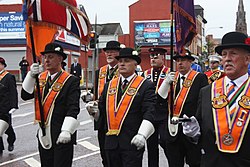The Twelfth - Wikipedia, the free encyclopedia
Lead-up to the Twelfth
Northern Ireland's "marching season" begins at Easter. From then until the Twelfth the Orange Order and Protestant marching bands hold numerous parades. The most common of these are lodge parades, in which one Orange lodge marches with one band. Others, such as the "mini-Twelfth" at the start of July, involve several lodges.
From June to August, Protestant, unionist and loyalist areas of Northern Ireland are decorated in a 'loyal' style. Streets and houses are bedecked with bunting and flags (mainly the Union Flag and Ulster Banner). The bunting and flags are usually flown from lamp-posts. Kerbstones may be painted red, white and blue and murals may be made. Wooden arches, bedecked with flags and Orange symbolism, are raised over certain streets.[5]
The raising of flags and arches near Irish Catholic and nationalist areas, or in "neutral" areas, had led to many violent clashes. Flying the flags of illegal loyalist paramilitaries, such as the Ulster Volunteer Force (UVF) and Ulster Defence Association (UDA), is especially contentious when deliberately erected outside Catholic churches and schools.[6]
Eleventh Night
Main article: Eleventh NightOn the night before The Twelfth—the "Eleventh Night"—huge bonfires are lit in many Protestant, Unionist and Loyalist areas of Northern Ireland. In many Protestant communities the bonfires are seen as family-friendly community celebrations. However, not all Protestants attend the bonfires and people from the Irish Catholic community avoid them. Some Eleventh Night bonfires involve sectarian and loyalist paramilitary displays. Symbols of Irish nationalism/republicanism (such as the Irish tricolour) and symbols of Catholicism are sometimes burnt on the fires.[7] Loyalist paramilitaries have also used the event to hold "shows of strength" – which often involve masked gunmen firing volleys of shots into the air.[7] Another issue that has been raised is drunkenness and violence amongst those attending.[7] More recently, there has been criticism that most of what is burnt causes serious environmental pollution.[7] However, in recent years, there have been attempts to make the bonfires more family-friendly and environmentally-friendly.[8]
In 2012 some bonfires in Belfast burned Polish flags as well as the Irish Tricolour. The Polish Association of Northern Ireland described it as "racist intimidation".[9]
Main events
The main way in which the Twelfth is celebrated is through large parades involving Orangemen and supporting bands. Most of the parades are in Northern Ireland, though Orange lodges elsewhere often hold parades too. The parade usually begins at an Orange Hall, proceeds through the town and out to a large field where the marchers, their friends and family, and the general public gather to eat, drink and listen to speeches by clergymen, politicians and senior members of the Order. In the past the Twelfth has been a major venue for discussion of the political issues of the day. A church service will also be held and sometimes band prizes will be awarded.[10] Within Northern Ireland, each District Lodge usually organises its own parade. In rural districts the parade will rotate around various towns, sometimes favouring those in which there is less likely to be trouble, but in other years choosing those in which it is felt the 'right to march' needs to be defended.

Orangemen in full regalia on 12 July 2011 in Belfast
In Northern Ireland, there is a long tradition of Protestant and loyalist marching bands, which can be found in most towns. The Orangemen hire these bands to march with them on the Twelfth. The bands have a reputation as being less respectable than the Orangemen, although they are seen by many as serving the useful purpose of keeping young men from working class areas out of trouble. An instrument almost unique to these marches is the Lambeg drum. Popular songs include "The Sash" and "Derry's Walls". Explicitly violent songs such as "Billy Boys" may also be played.
The vast majority of marchers are men, but there are some all-women bands and a few mixed bands. Some all-male bands have female flag or banner carriers. There are also some Women's Orange Lodges who take part in the parades. Orangewomen have paraded on the Twelfth in some rural areas since at least the mid-20th century, but were banned from the Belfast parades until the 1990s.

Orangemen returning from the field less formally
Orangemen on parade typically wear a dark suit, an Orange sash, white gloves and a bowler hat.[8] Certain Orangemen carry a ceremonial sword. In hot weather, many lodges will parade in short-sleeved shirts. Orangewomen have not developed a standard dress code, but usually dress formally. The supporting bands each have their own uniforms and colours. Both the Orangemen and bands carry elaborate banners depicting Orange heroes, historic or Biblical scenes, and/or political symbols and slogans. The most popular image is that of King William of Orange crossing the River Boyne during the famous battle.[11]
At the field, some lodges and bands don humorous outfits or accessories and make the return journey in them, and the mood is generally more mellow, although in times of tension it can also be more aggressive.
The Northern Ireland parades are given extensive local TV and press coverage and the BBC program 'The Twelfth' is the longest running outside broadcast program in Northern Ireland.